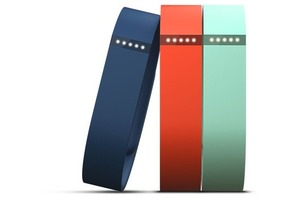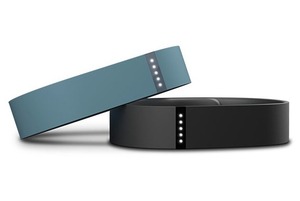Review: The Fitbit Flex wristband bests its closest competition
AT A GLANCE
The Fitbit Flex matches the core functionality of the company's other socially-connected digital pedometers, but it's worn on the wrist. Its Bluetooth syncing and durability help it best competitors like...
I’m writing these words at 2.5 miles per hour. For a couple of years now, I’ve worked on a treadmill desk—and while my number one motivation is healthiness, a secondary and unexpected inspiration to get the treadmill running is simply this: I need to get more steps than my friends do.
I’ve used (and occasionally reviewed) a variety of fitness tracking devices, among them various models of the Fitbit (the Ultra, the Zip), the Striiv, and the Jawbone Up. To some, they’re glorified pedometers; to me, they offer plenty more: These devices can track things like your steps walked, distance covered, stories climbed, and sleep … slept. And they let you see how your numbers stack up against your friends, too. Knowing that Mary’s inching up on 200,000 steps for the week is enough to keep me treading even at 4pm, when I briefly consider switching to my seated setup to conclude my workday.
Many fitness trackers are meant to be clipped onto your clothing or dropped in your pocket (I usually use the latter approach). I’ve been using a Fitbit Zip in my pocket as my primary tracker for months. Other trackers, like the Up and the Nike Fuelband, are instead wrist-worn bracelet-style accessories. Fitbit has now released its own foray into the wristband tracker space with its soft and rubbery Fitbit Flex.
We’re with the band
The $100 Flex ships with two adjustable wristbands—one large, one small. The small band fits wrists from 5.5 to 6.9 inches in diameter; the large band fits wrists from 6.3 inches to 8.2 inches. I wore the large band (the only one my review unit shipped with). The straps are adjustable, with a tooth and groove style familiar to anyone who’s ever tightened a baseball cap.
The bands come in a variety of colors: blue, teal (green), tangerine (orange), black, and navy. Right now, you can only buy the Flex in blue or black. Three-packs with the other color bands are available for $30. The actual tracker itself isn’t permanently attached to your band; if you order new Flex bands, you pop your tracker out from one and insert it into the new one.
Despite my experience with similar devices, I can admit that when my Fitbit Flex first arrived, I had no idea what to do with it. In lieu of a manual, I found only an instruction to get started by reading instructions online. Fair enough.
Using the Fitbit iPhone app, I discovered how to pop out the tracker from the band and then started charging it with the included USB adapter cable. (You’ll need that cable to charge your Flex, so don’t lose it. Fitbit’s online store doesn’t currently list the cable as available for individual purchase, but the company charges $10 for a similar adapter for its One tracker.) Five LEDs grace the exterior of the tracker, and they intermittently light up and blink while the device is charging.
Unlike the Jawbone Up, the Fitbit Flex doesn’t feel at all fragile. The rubbery Flex feels like a Swatch watchband and wraps simply around the wrist. That’s in comparison to the rigid Up, which I often feel I might stretch too widely while putting it on or taking it off. That said, fastening the Flex on my wrist requires just a smidgen more effort than I’d prefer; there’s usually about 30 seconds of squeezing the teeth into the Flex band’s holes before I finally get it.
Fitbit says the Flex is sweat-proof, rainproof, and water resistant, and that you can wear it in the shower or submerge it up to ten meters. I showered with mine on and wore it in the rain; it still works.
That syncing feeling
Like other newer Fitbit trackers, the Flex can sync via Bluetooth. That means that it can sync with the iPhone 4S or 5, Samsung’s Galaxy S3 and Note II (and newer), and third-generation iPads (and newer), withsupport for more devices coming soon. The Flex ships with a tiny USB Bluetooth dongle that you can use to pair the device with your Mac or PC. But if you sync via your phone or tablet instead, you can ditch the dongle entirely.
Also like other recent Fitbit models, the Flex optionally supports background syncing. You need to manually enable the feature in the Fitbit app, and you’ll likely need to relaunch the app from time to time to get it and your mobile device to pair again. When you do have the Fitbit app running—and it’s successfully paired with your Flex—you actually get a real-time updating step count.
Syncing the Flex via Bluetooth is far superior to the approach embodied by the Up. Jawbone’s tracker must be plugged into your device’s headphone jack, and the plug is hidden behind a removable, easy-to-lose cap. The only removable piece on the Flex to worry about is the tracker itself, but it seals into the band without any other removable parts. In theory, you should only be removing the tracker when you’re sticking it into the charger, which ideally will make it much harder to lose than the Up’s cap (which doesn’t have a special storing place when it’s removed).
What Flex tracks
Flex tracks your steps taken, distance traveled, and sleep. Unlike some Fitbit models, it does not count how many flights of stairs you climb. It also calculates your calories burned each day and how much “very active” time you spend each day.
On every other Fitbit model, you can look at the tracker to check in on those numbers. The Flex’s only display is its five LEDs. When you set your daily step goal with the Flex, you can double-tap the wristband to see an approximation of how far along you are: Each illuminated LED indicates a 20 percent increment of your step goal that you’ve achieved that day.
Fitbit used to show a confusing number for your calories burned, which would include not just the calories you had burned through movement, but also the calories burned thanks to your basal metabolic rate. The Fitbit app now shows the calories burned thorough the body’s natural BMR process—but only until you start logging steps for the day, at which point only the calories the tracker logs you as actively burning through motion are displayed.
When you’re ready to sleep, you tap the Flex rapidly for one to two seconds; the band vibrates and dims its LEDs to show you’ve entered sleeping mode. You need to repeat that tapping gesture when you wake up, to take the band out of sleeping mode. Flex tracks how long you’re alseep and the quality of that sleep. You get data including how long it takes you to fall asleep, how many times you wake up in the night, how long you stayed in bed, and how long you were actually asleep.
To see your Flex-tracked numbers, you use the Fitbit app for your device or the Fitbit website. The app and website are both customizable with your personal goals, and you control what data is displayed. The charts aren’t as interactive or visually compelling as the data Jawbone’s Up app provides, but the data is just as readable.
At Fitbit’s website, you can indicate whether you wear your Flex on your dominant or non-dominant hand, which adjusts the tracking in ways that the company doesn’t quite make clear. You can also indicate whether the band should use “sensitive” sleep tracking or not; the latter setting, Fitbit says, is for folks who lie awake very, very still and those with certain sleep disorders.
Cause for alarm
You can also use the Flex to wake yourself up in the morning. The band can’t make noise; like the Up, it wakes you by vibrating against your wrist. You can set alarms via the Web or the app, and they’re customizable as you’d expect. You might set an alarm to recur on specific weekdays but not on weekends, for example.
The Flex does not offer a “smart alarm” style feature that numerous other products include—among them, again, the Up. Such smart alarms wake you within 30 minutes of your set wake up time, but aim to detect when you’re at your lightest sleep before doing so, to make the rousing process gentler.
In fact, you can set up to eight separate alarms with the Flex, though you probably shouldn’t. Fitbit warns that “setting multiple alarms may drain your Flex’s battery.” And the Flex’s battery life isn’t stellar to begin with: Fitbit estimates you should get about five days before needing a charge. The band requires about three hours to charge fully. (The Jawbone Up lasts about ten days on a single charge.)
You can check the Flex’s current battery level within the Fitbit app or at the website. I have been spoiled by the Zip, which uses very cheap, disposable batteries that last six months or so. Never having to charge the tracker is nice.
Bottom line
The Flex works. Compared to other trackers, its numbers seem accurate. It’s comfortable and non-invasive on my wrist, though I do find it slightly annoying to put on. I do miss seeing a true reflection of my step count on the device, though it pairs so quickly with the Fitbit app for iPhone that I’ve adjusted pretty well.
There are advantages to wrist-worn trackers: They’re harder to lose, since they attach to your body, unlike the variety of tinier trackers that go into a pocket or clip onto clothing. And they’re far less likely to accidentally end up in the washing machine.
However, there are disadvantages, too: If you don’t love the look, or if your Flex doesn’t match your outfit, you’re forced to shove the band in your pocket. (You could ostensibly put just the very tiny tracker in your pocket, but I’d be scared about losing the thing.) And while wrist-worn trackers can accurately measure steps in most conditions, they’re actually lousy for treadmill desk users like me; the unusual setup confuses the Flex (and the Up).
I like the Flex’s look, though. And I like the Up’s look too. While the Up app is better than Fitbit’s, there’s a lot more activity on the Fitbit side. More people use Fitbit trackers, and that’s where I compare my stats with most of my friends’ numbers.
The Flex’s hardware feels more rugged than the Up, and thus less at risk of accidental damage. Syncing the Flex is far superior too, though again, I do miss the Up’s better battery life.
All told, if you want a wristband tracker, I think the Flex is the one to get right now. I’ll likely still go back to the Zip, because the replaceable battery really works for me. But if you prefer the harder-to-lose wristband approach to social step tracking, the Flex is a bit better than the Up.
Source : http://www.techhive.com/






Comments
Post a Comment